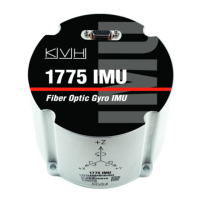This document contains proprietary information of KVH Industries, Inc. and neither this document nor said proprietary information shall be
published, reproduced, copied, disclosed, or used for any purpose without the express written permission of a duly authorized KVH representative.
Page 61 of 77
On the 1775 IMU, the external MSYNC input has a short debounce protection time on its
active (rising MSYNC+/ falling MSYNC-) edge of approximately 0.5 µs. This is followed by a
hold-off time of approximately 92 µs before it will recognize another active edge. This hold-off
time is to prevent retriggering the output, possibly from noise on the interface cable. There is
also a short (~ 1 µs) debounce protection time on its falling edge. Noise such as signal
reflections or crosstalk of the external wiring should be avoided by careful design of the
external wiring harness. However, setting the timing of the MSYNC input duty cycle such that
the falling edge of external MSYNC falls within the hold-off period can help ensure proper
MSYNC operation.
When selecting the external MSYNC signal as the output data request source, the system will
automatically switch the filter to use the Uniform Averager type. This will override any previous
filter type selection the user has configured (including a custom filter). It will not, however,
change the filter enable/disable configuration. The change to Uniform Averager is done so the
user is not forced to provide a regular periodic clock, but rather use the Master
Synchronization Input as an arbitrary aperiodic request for data. You may override this and
install any filter you choose. You can select from a predefined or custom eighth-order filter by
using a combination of the =DR, =FILTTYPE, =FC20, and =FILTEN commands. These must
be sent AFTER the =MSYNC,EXT command.
NOTE: The unit assumes that the user will always want data at a frequency greater than 1/2 Hz. If a rising edge
of the MSYNC signal is not detected within two seconds, the unit will consider this a fault condition and will
output data at the two-second interval. When the next MSYNC signal rising edge is detected, the unit will
resume synchronized output. This may be convenient as an indication that the user’s MSYNC signal was not
recognized by the unit (e.g., perhaps due to cabling or other error condition).
10.3.1 Example 1
The user wishes to use a Uniform Averager with MSYNC. The Averager is the default filter
when using MSYNC, so no additional configuration is needed.
=config,1
=msync,ext
=config,0
10.3.2 Example 2
The user wishes to enable MSYNC while turning off the filters entirely (i.e., user does not want
the IMU to implement either a Uniform Averager, or any kind of 8
th
order anti-aliasing filter; this
is not recommended by KVH due to aliasing of the output data). The =FILTEN configuration is
not changed automatically by the =MSYNC command, so this could be done in reverse order
or at some time previously. Send the following commands to the unit:
=config,1
=msync,ext
=filten,0
=config,0

